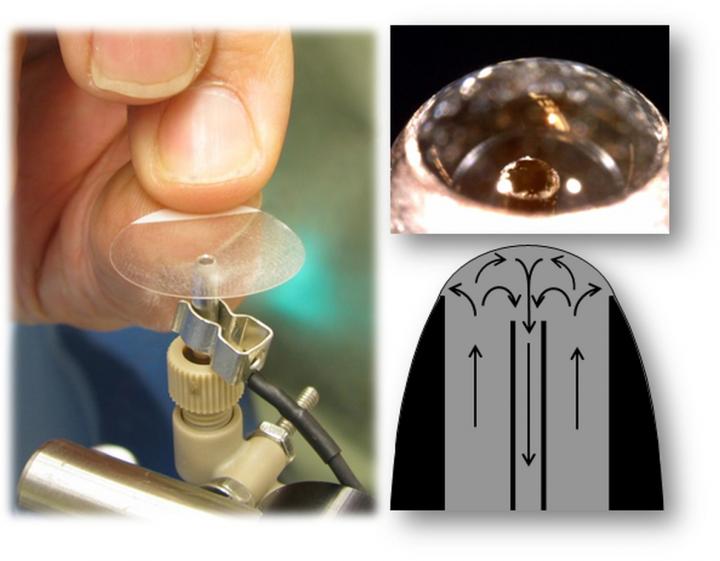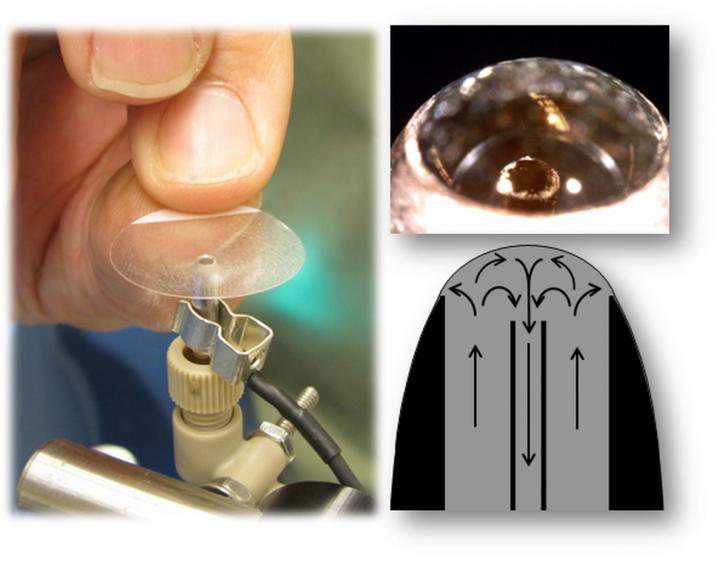
Credit: ORNL
OAK RIDGE, Tenn., Nov. 4, 2016–Researchers at the Department of Energy's Oak Ridge National Laboratory have received seven R&D 100 Awards in recognition of their significant advancements in science and technology. The honorees were recognized on Nov. 3 at the 54th annual R&D 100 Conference, sponsored by R&D Magazine.
The awards, known as the "Oscars of Invention," honor innovative breakthroughs in materials science, biomedicine, consumer products and more from academia, industry and government-sponsored research agencies.
This year's seven honors bring ORNL's total of R&D 100 awards to 200 since their inception in 1963.
ORNL researchers were recognized for the following innovations:
Oak Ridge Graph Analytics for Medical Innovation was developed by a team of ORNL researchers led by Sreenivas Sukumar in collaboration with the National Library of Medicine.
ORiGAMI is an artificial intelligence system designed to search, collect and connect medical literature resources to improve medical research discovery.
The open source algorithm can search and process NLM's entire MEDLINE database about 1,000 times faster than a normal workstation, find unexplored connections in medical texts and reason with the vast amounts of available information added every day.
While most search engines look for keywords in titles and abstracts, ORiGAMI learns language patterns from its users and literature and is able to search in-depth for hidden associations that other searches might miss.
Already, the engine has helped researchers investigate possible carcinogens, explore drug-disease interactions and find other serendipitous connections between disparate medical sources.
The development team was Sreenivas Sukumar, Larry Roberts, Sangkeun Lee, Alexandra Zakrezewksa (Yale University), Katherine Senter (University of Pennsylvania), Seokyong Hong (North Carolina State) and Seung-Hwan Lim.
Funding for this project was provided by the Laboratory Directed Research and Development Program.
The Roof Savings Calculator Suite was developed by a team of researchers from ORNL, Jacksonville State University and White Box Technologies.
The Roof Savings Calculator is a Web-based tool for simulating energy flow and loss in businesses and homes and predicting the cost-effectiveness of cool roofing and attic technologies based on building type and location.
The suite integrates the AtticSim engine with the DOE-2.1E whole-building engine to create hour-by-hour annual simulations of building heating and cooling loads and estimate the impact of cool roofing products on energy and cost savings.
It is more accurate and customizable than the current DOE and EPA energy calculators and is designed to educate builders and consumers about the money saving potential of roofing upgrades.
The development team was Joshua New, William Miller, Aaron Garrett (Jacksonville State University) and Yu Huang (White Box Technologies).
This project was funded by the DOE's Building Technologies Office, the California Energy Commission, White Box Technologies, and CentiMark, with support from additional private companies and trade associations.
G-Mode: Full Information Acquisition in Scanning Probe Microscopy and Spectroscopy was developed by a team of ORNL researchers led by Stephen Jesse.
Scanning probe microscopy uses a rastering probe to map the shape of surfaces and capture physical and chemical properties of materials on the nanometer and atomic levels. However, this approach is traditionally limited to a minute fraction of available information, making interpretation of observed nanoscale phenomena much more difficult.
G-Mode uses a custom controller to rapidly collect and thoroughly process the information flow from a microscope detector in its entirety, yielding all accessible information about minute changes sensed by the probe as it interacts with nanoscopic volumes of a sample.
While competing technologies focus on recording a single, high quality component of the probe signal, they can incidentally filter away or ignore information. G-Mode uses a fundamentally different approach by capturing and storing almost 200 million interactions streaming from the detectors per scan. It then processes the data through advanced machine learning algorithms to expose valuable, information-rich correlations and produce large high-resolution images of dynamic material properties 3,500 times faster than conventional state-of-the-art methods.
The development team was Stephen Jesse, Liam Collins, Suhas Somnath, Sergei Kalinin and Alex Belianinov.
G-Mode was funded by ORNL's Center for Nanophase Materials Science, a DOE Office of Science User Facility.
Virtual Environment for Reactor Applications was developed by a consortium of researchers from ORNL, the Electric Power Research Institute, Westinghouse Nuclear and Idaho, Sandia and Los Alamos national laboratories.
VERA is a physics simulation tool that visualizes the internal processes of commercial nuclear fission power plants and predicts reactor behavior in a number of potential scenarios.
The engine allows nuclear technicians to produce 3-D, high-fidelity power distributions to simulate atomic particle behavior and core conditions on a reactor-wide scale.
It has demonstrated the power up process of a new plant, modeled accidents and emergency situations and examined the effects of corrosion on fuel rod performance.
The development team consisted of 42 members. The ORNL researchers were Jess Gehin, John Turner, Kevin Clarno, Benjamin Collins, Gregory Davidson, Thomas Evans, Andrew Godfrey, Steven Hamilton, Douglas Kothe, Rose Montgomery, Robert Salko, Srdjan Simunovic, Stuart Slattery and Shane Stimpson.
VERA was funded by the DOE's Consortium for Advanced Simulation of Light Water Reactors.
U-Grabber was developed by a team of ORNL researchers led by Sheng Dai in collaboration with the University of Tennessee and 525 Solutions.
The U-Grabber is an adsorbent material designed to extract uranium and other metals from water inexpensively and efficiently.
The material is made from polyethylene fibers, similar to PVC, woven into braids and grafted with chains of a uranium-attractive chemical called amidoxine. The free-floating uranium in the water binds with the fibers and can be extracted, purified and sold as nuclear fuel.
The fibers can be reconstituted and reused, are cheap to produce at scale and can bolster dwindling terrestrial supplies of uranium. They can also be customized to bind with other toxic or valuable aqueous metals, providing an environmentally sound method of cleaning bodies of water such as mines or fly ash ponds.
The development team was Sheng Dai, Suree Brown (UT), Robin Rogers (525 Solutions), Christopher Janke, Richard Mayes, Tomonori Saito and Ronnie Hanes (525 Solutions).
U-Grabber was funded by the DOE's Office of Nuclear Energy.
Open Port Sampling Interfaces for Mass Spectrometry were developed by ORNL's Gary Van Berkel and Vilmos Kertesz.
The most difficult usability barrier for mass spectrometry is producing and transferring viable samples into the device. The Open Port Sampling Interfaces remove this impediment and allow easier, universal input of samples via accessible intake ports.
The ports, one a shallow swirling vortex, the other a conical solvent dome, use constantly flowing liquid streams to convey the sample into the ionization source of the spectrometer. They accept many types of samples, from organic oils to biological tissue, and produce results almost instantaneously.
The interfaces make mass spectrometry easier for novices and experts alike, as samples do not require processing and the ports are self-cleaning, reducing the risk of cross contamination.
Mass spectrometers modified with these new sampling interfaces combine speed, ease of use, and high imaging resolution to serve as a valuable tool in materials science, biology, chemistry and more.
This technology is licensed to SCIEX.
The development team was Gary Van Berkel and Vilmos Kertesz.
This project was funded by the DOE's Office of Science.
Waste Tire Derived Carbon was developed by a team of ORNL researchers led by Parans Paranthaman and the RJ Lee Group.
ORNL material chemists devised a proprietary process for repurposing discarded car tires as a source of carbon powder, a sooty hydrocarbon byproduct that can be modified to incorporate into anodes of lithium-ion batteries.
The recycled tires are shredded, cryogenically pulverized to powder and soaked in sulfuric acid, then roasted in a furnace to recover the carbon composite powders with a yield of more than 50 percent of the original mass.
The carbon powder is chemically similar to graphite but has a unique microstructure that is superior in rechargeable batteries, with a higher electrochemical performance and longer cycle life than the best graphite anodes.
A large-scale tire-to-battery conversion operation could reduce total battery production costs by 11-12 percent while improving electrical storage capacity and performance.
This inexpensive, environmentally beneficial and seemingly unlimited resource is an opportunity to repurpose more than 1 billion car tires discarded globally every year while meeting the rising demand for cheap carbon as the battery market continues to grow.
The development team was Parans Paranthaman, Richard Lee (RJ Lee Group), Amit Naskar, Yunchao Li (UT), Kokouvi Akato (UT) and Alan Levine (RJ Lee Group).
This project was funded by the DOE's Office of Science and ORNL's Technology Innovation Program.
ORNL also received a special recognition award from R&D Magazine for the Wireless Power Transfer Based Electric and Plug-In Vehicle Charging System, submitted by Toyota Motor Engineering & Manufacturing North America and co-developed by a team of ORNL researchers with support from Cisco Systems and the International Transportation Innovation Center.
The team developed the world's first 20-kilowatt wireless charging system for passenger cars and achieved 90 percent efficiency at three times the rate of the plug-in systems commonly used for electric vehicles today.
Providing the same speed with the convenience of wireless charging could increase consumer acceptance of electric vehicles and is considered a key enabler for hands-free, autonomous vehicles. Higher power levels are also essential for powering larger vehicles such as trucks and buses.
The high-power wireless charging system relies on a unique architecture that includes an ORNL-built inverter, isolation transformer, vehicle-side electronics and coupling technologies.
The ORNL researchers on the development team were Steven Campbell, Paul Chambon, Madhu Chinthavali, Omer Onar, Burak Ozpineci, Larry Seiber, David Smith, Lixin Tang, Cliff White and Randy Wiles as well as retired staff members Curt Ayers, Chester Coomer and John Miller.
Funding for this project was provided by the DOE's Energy Efficiency and Renewable Energy Office, Office of Vehicle Technologies.
UT-Battelle manages ORNL for the DOE's Office of Science. The DOE Office of Science is the single largest supporter of basic research in the physical sciences in the United States and is working to address some of the most pressing challenges of our time. For more information, visit the Office of Science website.
###
Image: https://www.ornl.gov/sites/default/files/news/images/Award%20Picture.jpg
Cutline: A close-up look at the Open Port Sampling Interfaces for Mass Spectrometry, one of ORNL's seven 2016 R&D 100 Award winners.
NOTE TO EDITORS: You may read other press releases from Oak Ridge National Laboratory or learn more about the lab at http://www.ornl.gov/news. Additional information about ORNL is available at the sites below:
Twitter – http://twitter.com/ornl
RSS Feeds – http://www.ornl.gov/ornlhome/rss_feeds.shtml
Flickr – http://www.flickr.com/photos/oakridgelab
YouTube – http://www.youtube.com/user/OakRidgeNationalLab
LinkedIn – http://www.linkedin.com/companies/oak-ridge-national-laboratory
Facebook – http://www.facebook.com/Oak.Ridge.National.Laboratory
Media Contact
Sean Simoneau
[email protected]
865-241-0709
@ORNL
http://www.ornl.gov





